Log in or create new account to save this product to your wishlist.
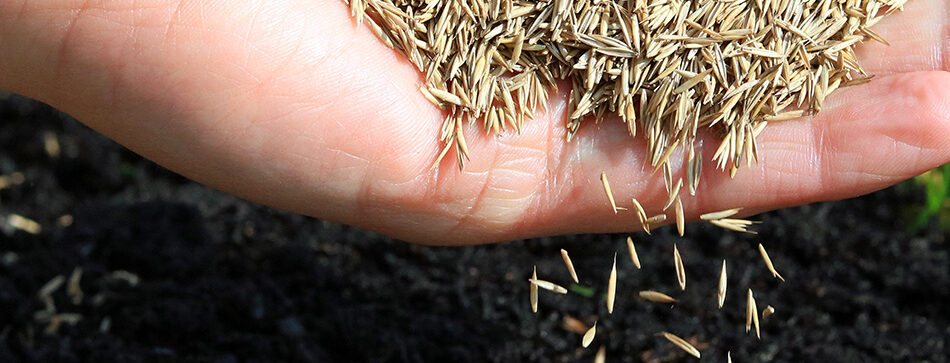
Overseeding Your Lawn: When, Why & How?
A thing that is sometimes necessary, is to overseed your lawn. But why is this actually necessary? And when is the best time to do it? We'll explain it all!
🌱 All important maintenance moments for your lawn during the year. Leave your email and we will send you the lawn calendar for free.
Enter your email
Receive the lawn calendar in the mail
Enjoy a green lawn all year round!

- Order by 2PM = shipped today
- 250.000+ satisfied customers!
- 60 day satisfaction guarantee
Even with meticulous lawn care, bare patches can emerge. Weeds, diseases, and heavy usage can diminish the beauty of your lawn. Fortunately, there’s something like overseeding your lawn!
- Why is it important to overseed your lawn ?
- When is the right time to overseed my lawn?
- Overseeding during spring
- Overseeding in the summer
- Overseeding in autumn
- Which grass seed to use for overseeding?
- Overseeding your lawn: the checklist
- How to overseed your lawn – a step-by-step guide
- Bonus: 3 tips for proper aftercare
- FAQ
Whether you call it overseeding or reseeding, the principle remains the same: you simply replenish those bare spots in your existing lawn with fresh grass seed. It’s akin to a rejuvenating treatment for your grass, preserving its youthful vibrancy. Discover how to tackle this, and restore the green splendour of your lawn.
Why is it important to overseed your lawn ?
There are various reasons to undertake overseeding. It could be that you’ve recently sown a new lawn, and not all the grass seeds have germinated. Perhaps bare patches have emerged due to weeds, pests like chafer grubs, leatherjackets, or moles, lawn diseases, or simply the weather. Additionally, over time, every lawn naturally becomes thinner.
This often occurs gradually, and you might only notice it when it’s too late. Once your lawn dries out, clover and moss take over. Even though your lawn might initially appear healthy, it eventually transforms into a felt-like carpet that chokes the remaining grass blades. Overseeding is the preventative solution!
By overseeding in a timely manner, new grass blades sprout, replacing the old ones and preventing weeds from taking hold. Young lawns are also more resilient against diseases and weeds. Overseeding brings rejuvenation to the lawn.
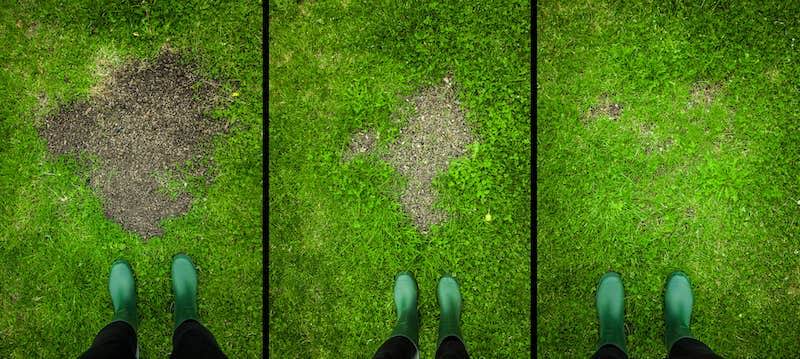
When is the right time to overseed my lawn?
When is the optimal time to overseed your lawn? Except for winter, you can do this in any season. However, each season comes with its own set of challenges. Below, you’ll find details on each.
Overseeding during spring
In spring, the lawn awakens from its winter slumber. With rising temperatures, the first growth phase of the year begins. It’s an excellent moment to fill in bare patches that emerged during winter with fresh grass seed.
If you’ve fertilised your lawn in late autumn, there are still enough nutrients in the soil in spring to nourish the newly seeded grass. If your lawn isn’t in top condition, remove any emerged weeds and provide a spring fertilisation before starting overseeding.
Give your new grass a boost before summer begins with an additional round of fertilisation. By then, the lawn should form a healthy and dense turf, better equipped to withstand the hot summer months.
Overseeding in the summer
Overseeding in the height of summer is not advisable, but in late summer, it can work well under the right conditions. During summer, your lawn faces challenges like heat, drought, foot traffic, and possibly garden furniture and a pool. The grass undergoes stress and requires time to recover. Strengthen the roots and densify the turf with fertilization and proper care. Once temperatures drop, and the soil temperature falls below 25°C, late summer is a suitable time for overseeding.
Remember: watering is crucial in this season!
Overseeding in autumn
Autumn is an excellent season for overseeding. Around mid-October, during the last growth spurt, the grass provides protection against the cold and the threat of moss and diseases in the upcoming winter months. Until that moment, the soil remains warm enough for grass seed to germinate. With some luck, autumn rains will provide natural irrigation for your lawn. Combined with autumn fertilisation, the young shoots will grow quickly and be ready for winter.
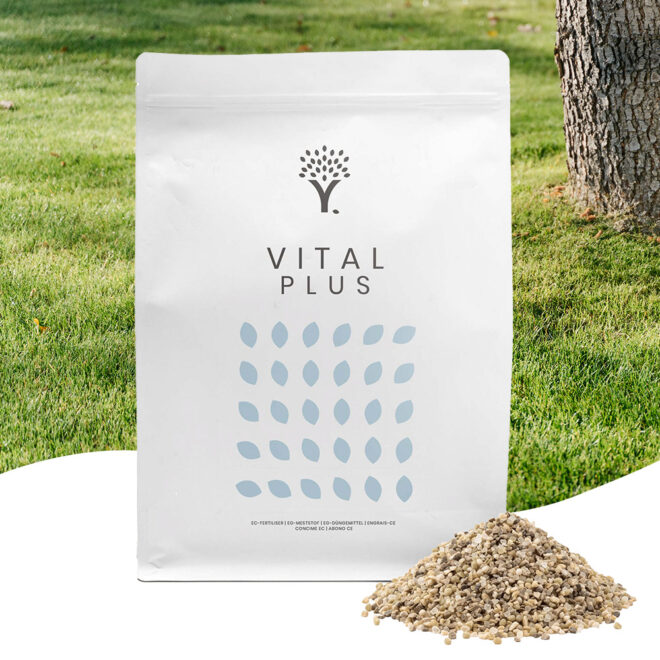
- Works all year-round
- A greener lawn in just three days
- Promotes a strong, healthy, and green lawn
Which grass seed to use for overseeding?
Choosing the right grass seed for overseeding depends on the type of lawn you have or want to create. The most common grass seed blends are suitable for sports and fun lawns, shade lawns, and ornamental lawns. Let’s delve into these three types.
Sports & Fun
Opt for this grass seed if you desire a robust lawn that can withstand heavy use. It’s the ideal choice for lawns subject to intense activities, where children play and pets roam. Our sports and fun grass seed comprises a blend of sturdy and finer grass varieties, promoting rapid growth and easy establishment.
Shade & Sun
Specially developed for lawns in the shade. If trees or nearby buildings create shade in your garden, opt for grass varieties that require less light. Our shade and sun grass seed thrives excellently in shaded areas. The grass has a fine-bladed structure and grows slowly. While it requires slightly more maintenance, it can tolerate short mowing.
Ornamental
Grass seed for ornamental lawns is perfect when you want to create a beautiful lawn that is not frequently trodden upon. Our premium lawn grass seed contains more fine-bladed varieties, ensuring a high ornamental value and tolerance to short mowing.
Overseeding your lawn: the checklist
You’ll need the following items to overseed your lawn:
- Grass seeds
- Hand spreader
- Rake
- Garden hose, sprinkler, or watering can
- Patience
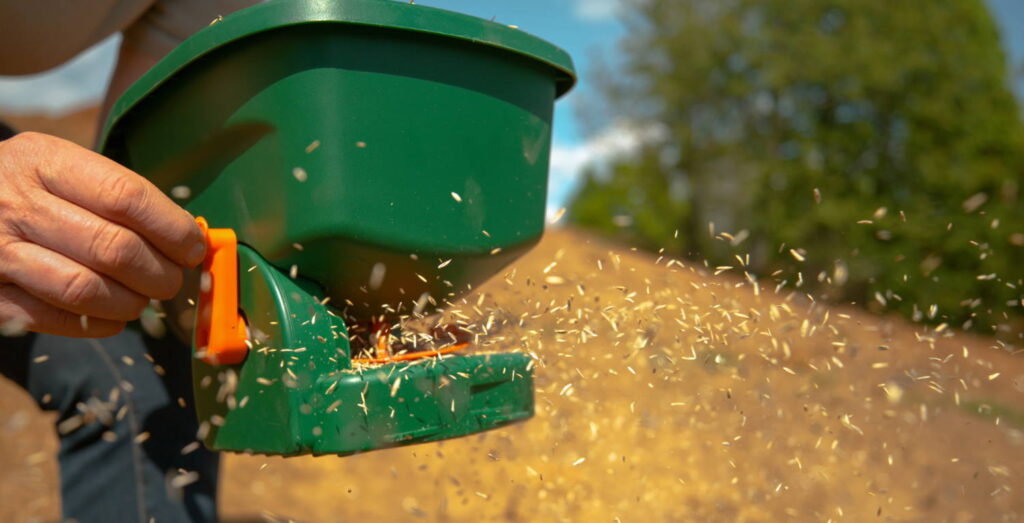
How to overseed your lawn – a step-by-step guide
It’s time to breathe new life into your lawn! Follow our step-by-step guide for the best results.
Step #1: Choose your grass seed and calculate the quantity
Select the grass seed that suits your lawn. Review the differences between sports and play lawn, shade lawn, and ornamental lawn mentioned above. Pay attention to quality when purchasing, ensuring the presence of ‘perennials’ for a sustainable outcome. We recommend using 17 grams of grass seed per square meter. For a new lawn, you’ll need double the amount.
Step #2: Mow your lawn
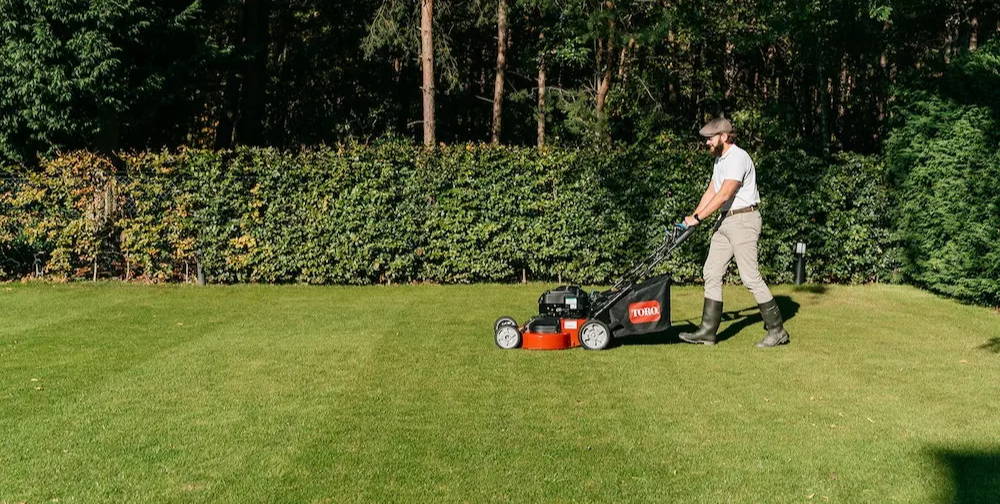
Mow the grass to a height of 2-3 centimeters. This makes bare patches more visible and creates space for the new grass. Mowing also ensures better contact between the grass seed and the soil, essential for optimal growth. Ensure the lawn is dry to prevent damage to the blades.
Step #3: Improve your soil
Examine the bare patches thoroughly. Pour water over the areas and observe drainage. If a puddle forms, the soil is compacted. Poke holes in the ground, fill them with sand, and rake the soil before overseeding. Remove moss, weeds, or yellow spots, and level the ground.
Step #4: Overseed
When the soil temperature is between 10 and 25 °C and there is light moisture, it’s time to seed. Distribute the grass seed evenly by hand or use a spreader. First, sow lengthwise and then widthwise.
Step #5: Press the seed into the soil
Lightly rake the grass seed to ensure contact with the soil, accelerating the germination process.
Step #6: Roll the soil with a roller
Use a lawn roller to roll the soil. This ensures the grass seed remains firmly in the ground and doesn’t wash away.
Step #7: Boost your lawn
Nourish your new and existing grass with a fertilization of 25 grams per square meter. Distribute it in the same manner as the grass seed.
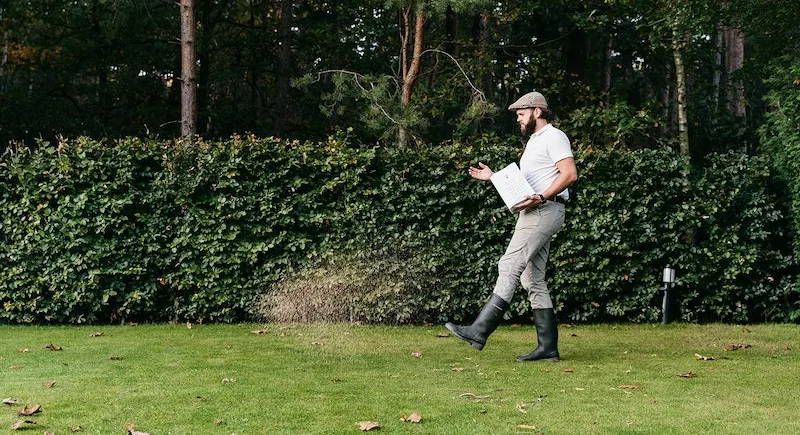
Step #8: Water
Begin watering immediately after fertilization and keep the soil moist until the seed germinates. Divide watering sessions throughout the day.
Step #9: Wait
You’re done! Give the new grass time to grow. Avoid walking on the lawn, and wait at least 3 weeks before giving the new grass its first mowing.
Bonus: 3 tips for proper aftercare
Tip #1: Watering
The importance of sufficient watering has been emphasized earlier, and it’s the key to successfully nurturing new grass. Inadequate water can lead to dehydration of the grass seed, hindering germination.
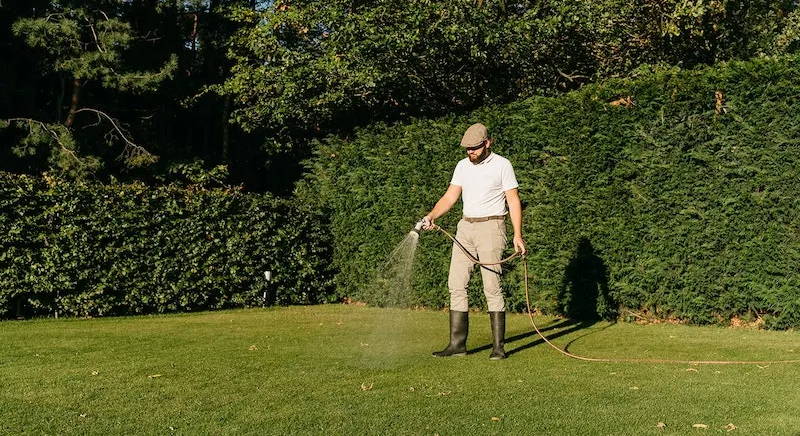
Tip #2: Avoid walking on the growing grass for the first 3 weeks
Give the grass seed time to establish roots and germinate. Resist the temptation to walk on the lawn during the initial 3 weeks.
Tip #3: First mow? Follow the 1/3 rule
If you’ve waited at least 21 days, and the grass is approximately 10 centimeters tall, it’s time for the first mowing. However, adhere to the 1/3 rule: don’t mow more than 1/3 of the height of the grass blades.
If you want the grass shorter, wait a few more days and repeat the process, again mowing a maximum of 1/3 of the height.
FAQ
Investigate the origin of the bare patches. If water isn’t draining properly, ensure aeration to let water, light, and nutrients reach the soil. If weeds are the culprit, remove them with roots intact, filling the gaps with garden soil. Generously seed the bare areas and lightly rake the soil.
Grass seed typically takes about 14 days to germinate. By approximately 21 days, the grass should be around 10 centimeters tall.
It’s best to wait around 4 days after overseeding before you fertilise. Otherwise, the fertiliser may stop the seed from germinating. If you need to do it at the same time, make sure you use a fertiliser developed for young lawns, such as MOOWY’s Lawn Starter.
Insufficient water hinders grass seed germination. Adequate watering is crucial for successful sprouting.
You can store grass seed for up to 3 years from the production date, especially in a cool, dark space. Even if the seed is older, it remains usable. While the germination power gradually decreases, it doesn’t vanish entirely.
Are you ready to overseed your lawn?
With this step-by-step guide and post-care tips, you’re ready to breathe new life into your lawn. Remember, patience is a green virtue, especially when it comes to growing grass. Continue nurturing your lawn, and soon you’ll be admiring a lush, green carpet!
Looking for more tips for a healthy and vibrant lawn? Explore our other articles on lawn care and garden maintenance.
And if you have any questions, feel free to reach out to us. We’re here to assist you.
Happy gardening!
-
How to Use Landscape Fabric ProperlyIf weeds or erosion in your garden are troubling you, landscape fabric might be the solution. We’ll explain how and when to use it properly, just keep on reading.Read more
-
How to Level a LawnThe secret to a beautiful garden is levelling the lawn. What's the best way to go about it? We are sharing our best tips!Read more
-
How to Prepare Your Garden for WinterWinter is coming! Get winter care tips for perennials, trees, shrubs, and more. Survive the colder months & come back stronger in the spring.Read more
-
Lawn Edges: Cutting, Mowing & Maintenance TipsFind out why maintaining lawn edges is important. How to cut and mow them. Check out our handy tips for the perfect lawn edging maintenance.Read more
-
How to Design Your Perfect North-Facing GardenNorth-facing gardens get less light than gardens of other orientations. But you can still bring it to life with the right plants and conditions. Find out how to make the most of your north-facing orientation.Read more
-
Identifying and controlling millet in your lawnMillet is an edible crop, loved for its edible, highly nutritious grain. However, you may find millet in your lawn, spread through bird droppings. Find out how to identify and control millet in your lawn.Read more
-
Top 12 Lawn Edging Ideas to Spruce Up Your Garden in 2023Adding a formal edge to your lawn is like dotting the i's and crossing the t's as far as lawn finish is concerned. Somehow, your lawn just doesn't look complete without one. Let us help inspire lawn edging that suits your outdoor space.Read more
-
Mowing your lawn BEFORE overseeding — this is how it works!Overseeding is an essential lawn care task. But make sure you cut your grass beforehand (otherwise, you'll have a jungle on your hands!).Read more
Leave a comment
Your answer will be displayed on the site and the interested party will be notified by email.
Leave a comment
Have a question or want to share your experience? Leave us a comment.

- Order by 2PM = shipped today
- 250.000+ satisfied customers!
- 60 day satisfaction guarantee

- Order by 2PM = shipped today
- 250.000+ satisfied customers!
- 60 day satisfaction guarantee

- Order by 2PM = shipped today
- 250.000+ satisfied customers!
- 60 day satisfaction guarantee

🌱 All important maintenance moments for your lawn during the year. Leave your email and we will send you the lawn calendar for free.
Enter your email
Receive the lawn calendar in the mail
Enjoy a green lawn all year round!






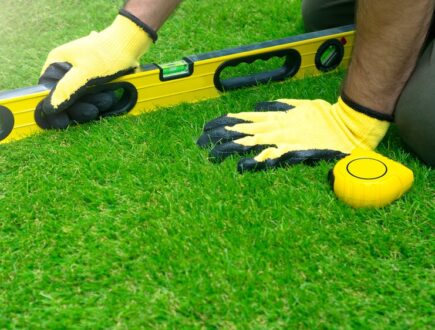
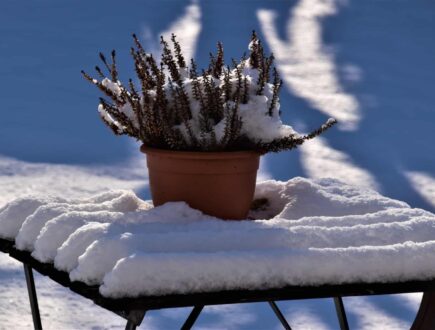
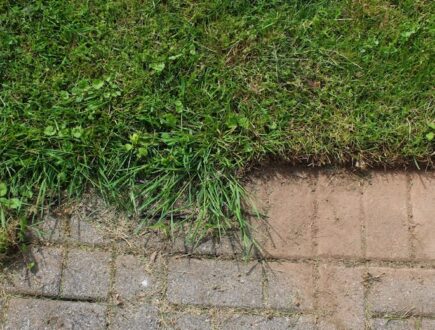
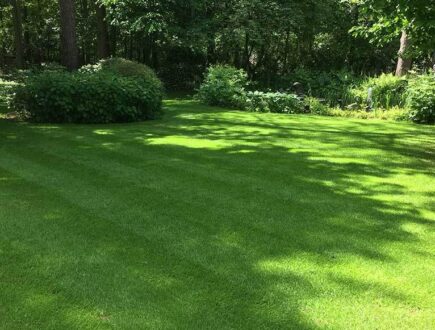
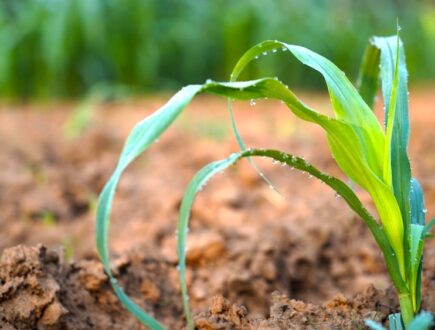
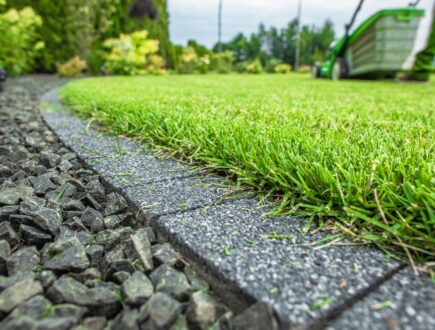
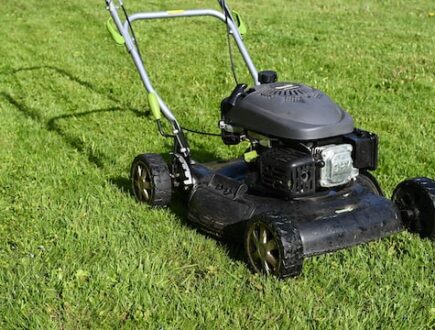



 Summer Deal! Get 15% off the
Summer Deal! Get 15% off the 




Comments (0)
There are no comments yet. Well then, what are you waiting for to
Be the first to write your comment!inaugurate this pretty page?
Do you have some comments?